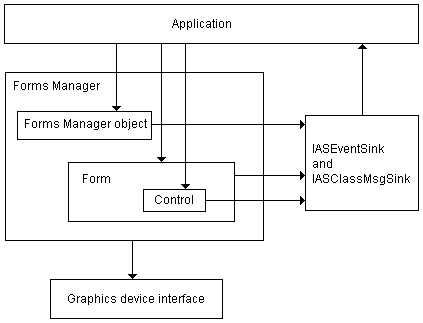
A Forms Manager is an ActiveX® control container that provides speech and keyboard navigation, input to all controls, and common services such as visual Help and application menus. A Forms Manager passes messages from one form to another and from the OS to a form.
An Auto PC application uses a Forms Manager to handle its forms, even if it uses only one form. The device context handle is derived from the form. An Auto PC application is composed of at least three COM objects:
Create each object with CoCreateInstance and access its other interfaces through the IUnknown interface. A Forms Manager’s primary interface is IfmManage, which provides an application with methods and common services for an application and its forms. In addition, a Forms Manager exposes the following specialized interfaces:
The following illustration shows an Auto PC application architecture.

Because a Forms Manager consists of several interfaces, it performs the following tasks:
 To create a Forms Manager
To create a Forms ManagerThe following code example shows how to create a Forms Manager.
HRESULT GetFormsManager()
{
HRESULT hr;
hr = CoCreateInstance(CLSID_FMMANAGE, NULL, CLSCTX_INPROC_SERVER,
IID_FMMANAGE,
(PVOID *) &g_pManage);
if (FAILED(hr)) goto LReturn;
WCHAR wszAppName[ _MAX_PATH +1 ];
//Use the name in the resource script with ID #1(STR_APP_SHELL_NAME)
LoadString(g_hInst, STR_APP_SHELL_NAME, wszAppName,_MAX_PATH );
g_bstrAppName = ::SysAllocString(wszAppName);
if (g_bstrAppName){
// Register the application as started with the Forms Manager.
// Send the Forms Manager the name of the faceplate on
// which to execute the application.
g_pManage->RegisterStartedApplication(FC_MAINFACEPLATE,
g_bstrAppName, 0, 0);
}
else {
hr = E_OUTOFMEMORY;
}
hr = g_pManage->MoveAppToForeground(GetCurrentProcessId(), 0, 0);
LReturn:
return hr;
}